CBSE Science Class 10 Sample Paper 2023: Science Sample Paper for the students of CBSE class 10 is out. The subject-wise sample papers for the current academic year 2022-23 are available in pdf format on the official website of Central Board of Secondary Education at cbseacademic.nic.in.
Although students often panic because of the common notion that Science is extremely difficult, you don't have anything to worry about. If you solve all sample papers and practice papers by CBSE board, you will glide through the whole subject very smoothly.
First, you should begin by checking the syllabus of the paper.
Here is the structure of the Science paper in CBSE class 10th:
CBSE Class 10 Science Course Structure
Theory Marks - 80
| Unit No. | Unit | Marks |
| I | Chemical Substances-Nature and Behaviour | 25 |
| II | World of Living | 25 |
| III | Natural Phenomena | 12 |
| IV | Effects of Current | 13 |
| V | Natural Resources | 05 |
|
| Total | 80 |
|
| Internal assessment | 20 |
Check the latest Course Structure, Exam Pattern, Deleted Topics & Assessment Details in CBSE class 10 Science Syllabus 2022-23.
Once you are familiar with the syllabus details, exam pattern and assessment details, you should stick with the prescribed NCERT textbook for Class 10 Science.
Now, moving on to the latest sample paper in hand:
CBSE Class 10 Science Sample Paper 2022-23
The paper begins with a few instructions for the students. Although the instructions would be available in the board exam question paper as well, it is suggested to acquaint yourself with these instructions beforehand to avoid any last minutes ruckus and panic in the exam hall.
The general instructions provided in the CBSE Class 10 Science Sample Question Paper 2022-23 are as follows:
General Instructions:
i. This question paper consists of 39 questions in 5 sections.
ii. All questions are compulsory. However, an internal choice is provided in some questions. A student is expected to attempt only one of these questions.
iii. Section A consists of 20 objective type questions carrying 1 mark each.
iv. Section B consists of 6 Very Short questions carrying 02 marks each. Answers to these questions should be in the range of 30 to 50 words.
v. Section C consists of 7 Short Answer type questions carrying 03 marks each. Answers to these questions should in the range of 50 to 80 words
vi. Section D consists of 3 Long Answer type questions carrying 05 marks each. Answers to these questions should be in the range of 80 to 120 words.
vii. Section E consists of 3 source-based/case-based units of assessment of 04 marks each with sub-parts.
Students of class 10 can see the complete content of the CBSE Class 10 Science Sample Question Paper 2022-23 to prepare for the upcoming CBSE Class 10 Board Exam 2023 in the best manner.
SECTION - A
Select and write one most appropriate option out of the four options given for each of the questions 1 – 20
Q 1. The change in colour of the moist litmus paper in the given set up is due to

i. presence of acid
ii. presence of base
iii. presence of H⁺(aq) in the solution
iv. presence of Litmus which acts as an indicator
(a) i and ii
(b) Only ii
(c) Only iii
(d) Only iv.
Q 2. In the redox reaction
MnO2 + 4HCl → MnCl2 + 2H2O + Cl2
(a) MnO2 is reduced to MnCl2 & HCl is oxidized to H2O
(b) MnO2 is reduced to MnCl2 & HCl is oxidized to Cl2
(c) MnO2 is oxidized to MnCl2 & HCl is reduced to Cl2
(d) MnO2 is oxidized to MnCl2 & HCl is reduced to H2O
Q 3.
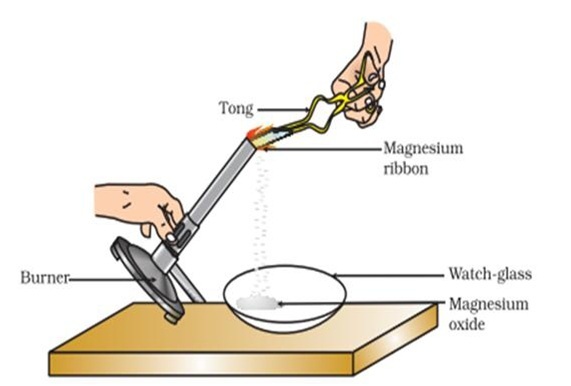
Which of the following is the correct observation of the reaction shown in the above set up?
(a) Brown powder of Magnesium oxide is formed.
(b) Colourless gas which turns lime water milky is evolved.
(c) Magnesium ribbon burns with brilliant white light.
(d) Reddish brown gas with a smell of burning Sulphur has evolved.
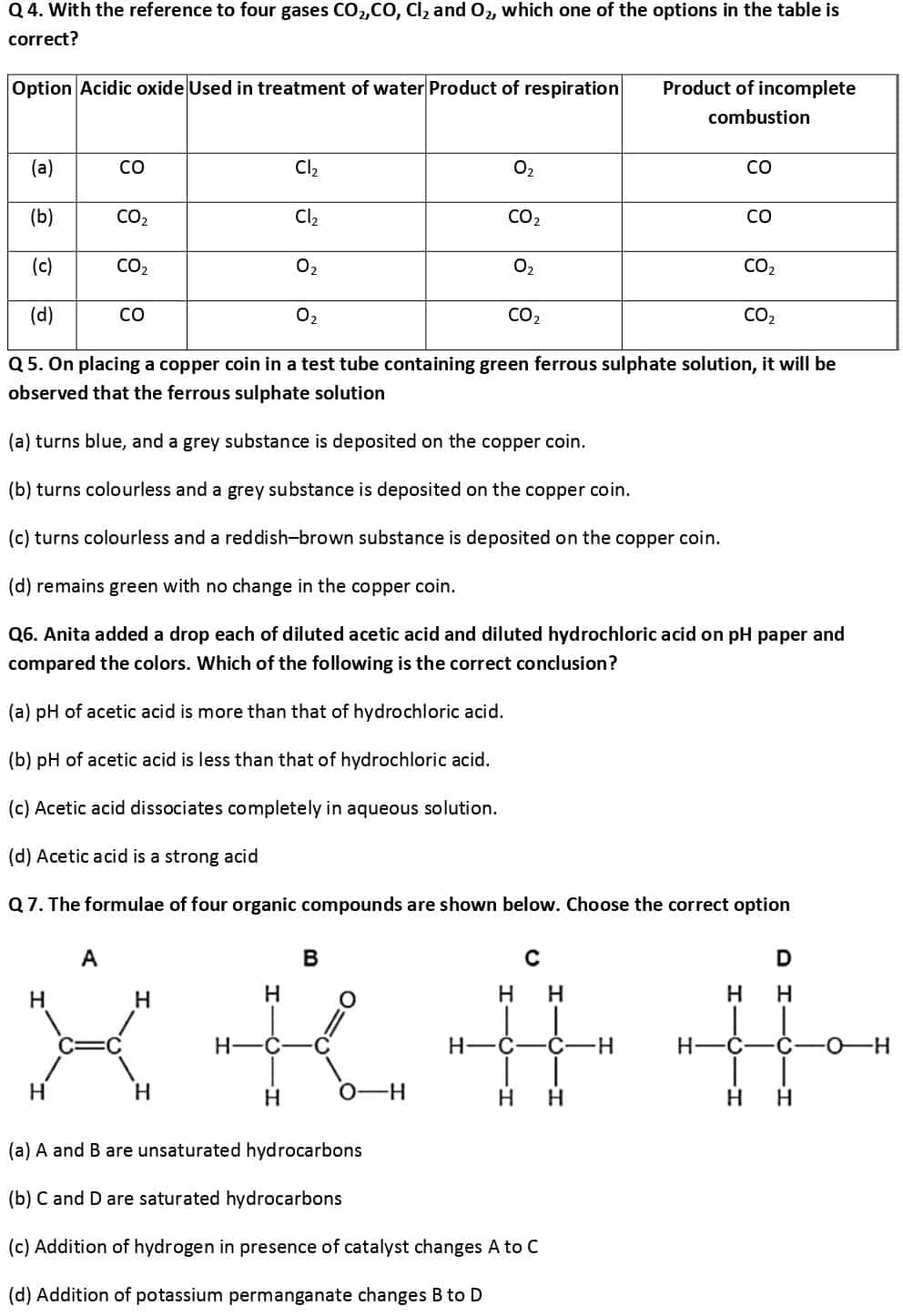
Q 8. In the given transverse section of the leaf identify the layer of cells where maximum photosynthesis occurs.
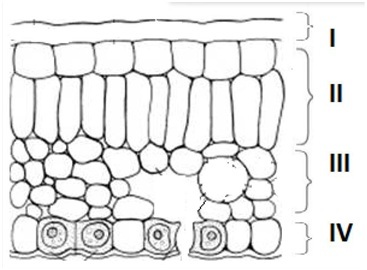
(a) I, II
(b) II, III
(c) III, IV
(d) I, IV
Q 9. Observe the experimental setup shown below. Name the chemical indicated as ‘X’ that can absorb the gas which is evolved as a by product of respiration.
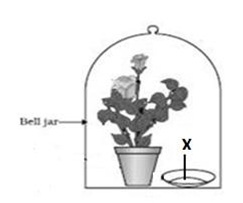
(a) NaOH
(b) KOH
(c) Ca (OH)2
(d) K2CO3
Q 10. If a tall pea plant is crossed with a pure dwarf pea plant then, what percentage of F1 and F2 generation respectively will be tall?
(a) 25%, 25%
(b) 50%, 50%
(c) 75%,100%
(d) 100%, 75%
Q 11. Observe the three figures given below. Which of the following depicts tropic movements appropriately?

(a) B and C
(b) A and C
(c) B only
(d) C only
Q 12. The diagram shown below depicts pollination. Choose the options that will show a maximum variation in the offspring.
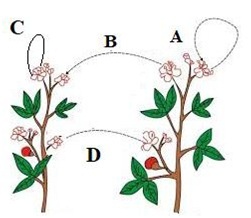
(a) A, B and C
(b) B and D
(c) B, C and D
(d) A and C
Q 13. A complete circuit is left on for several minutes, causing the connecting copper wire to become hot. As the temperature of the wire increases, the electrical resistance of the wire
(a) decreases.
(b) remains the same.
(c) increases.
(d) increases for some time and then decreases.
Q 14. A copper wire is held between the poles of a magnet.
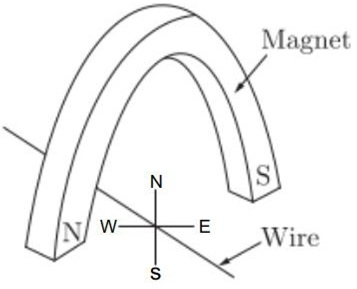
The current in the wire can be reversed. The pole of the magnet can also be changed over. In how many of the four directions shown can the force act on the wire?
(a) 1
(b) 2
(c) 3
(d) 4
Q 15.
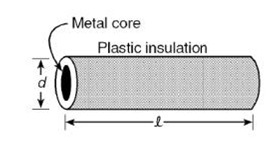
Plastic insulation surrounds a wire having diameter d and length l as shown above. A decrease in the resistance of the wire would be produced by an increase in the
(a) length l of the wire
(b) diameter d of the wire
(c) temperature of the wire
(d) thickness of the plastic insulation
Q 16. Which of the following pattern correctly describes the magnetic field around a long straight wire carrying current?
(a) straight lines perpendicular to the wire.
(b) straight lines parallel to the wire.
(c) radial lines originating from the wire.
(d) concentric circles centred around the wire.
Q. no 17 to 20 are Assertion - Reasoning based questions.
These consist of two statements – Assertion (A) and Reason (R). Answer these questions selecting the appropriate option given below:
(a) Both A and R are true and R is the correct explanation of A
(b) Both A and R are true and R is not the correct explanation of A
(c) A is true but R is false
(d) A is False but R is true
Q 17. Assertion: Silver bromide decomposition is used in black and white photography.
Reason: Light provides energy for this exothermic reaction.
Q 18. Assertion: Height in pea plants is controlled by efficiency of enzymes and is thus genetically controlled.
Reason: Cellular DNA is the information source for making proteins in the cell.
Q 19. Assertion: Amphibians can tolerate mixing of oxygenated and deoxygenated blood.
Reason: Amphibians are animals with two chambered heart
Q 20. Assertion: On freely suspending a current – carrying solenoid, it comes to rest in Geographical N-S direction.
Reason : One end of current carrying straight solenoid behaves as a North pole and the other end as a South pole, just like a bar magnet.
SECTION – B
Q. no. 21 to 26 are very short answer questions.
Q 21. A clear solution of slaked lime is made by dissolving Ca(OH)2in an excess of water. This solution is left exposed to air. The solution slowly goes milky as a faint white precipitate forms. Explain why a faint white precipitate forms, support your response with the help of a chemical equation.
OR
Keerti added dilute Hydrochloric acid to four metals and recorded her observations as shown in the table given below:
| Metal | Gas Evolved |
| Copper | Yes |
| Iron | Yes |
| Magnesium | No |
| Zinc | Yes |
Select the correct observation(s) and give chemical equation(s) of the reaction involved.
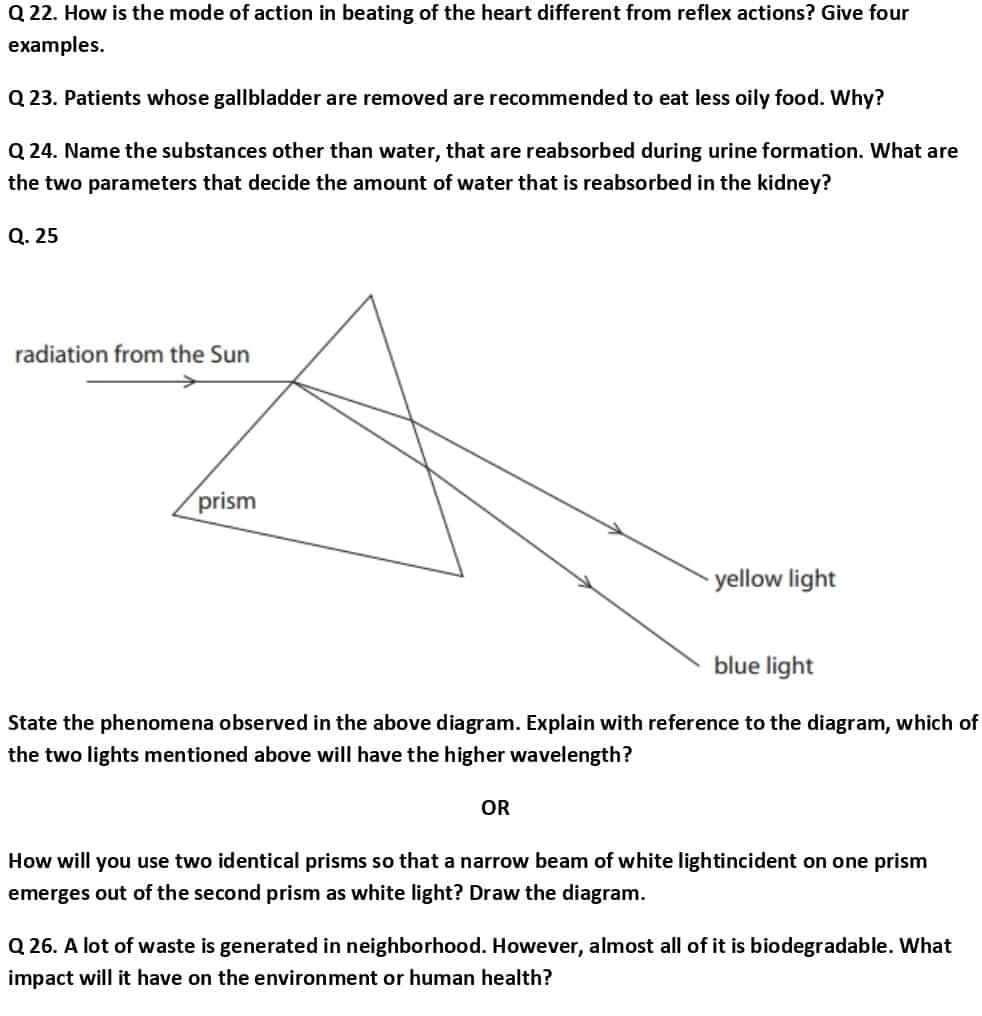
SECTION - C
Q. no. 27 to 33 are short answer questions.
Q 27.
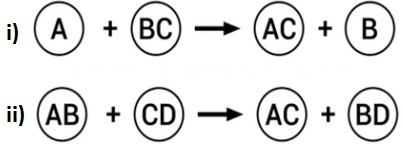
Identify the types of reaction mentioned above in (i) and (ii). Give one example for each type in the form of a balanced chemical equation.
Q 28.
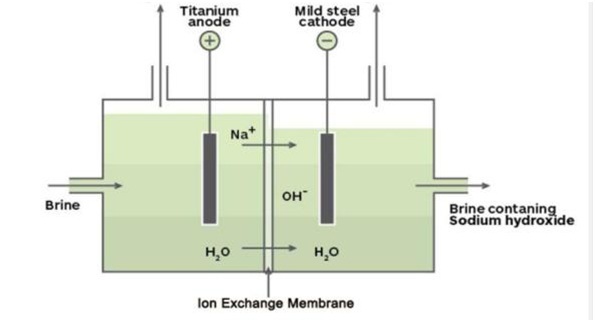
(a) Identify the gasses evolved at the anode and cathode in the above experimental set up.
(b) Name the process that occurs. Why is it called so?
(c) Illustrate the reaction of the process with the help of a chemical equation.
Q 29. The leaves of a plant were covered with aluminium foil, how would it affect the physiology of the plant?
OR
How is lymph an important fluid involved in transportation? If lymphatic vessels get blocked, how would it affect the human body? Elaborate.
Q 30. Rohit wants to have an erect image of an object using a converging mirror of focal length 40 cm.
(a) Specify the range of distance where the object can be placed in front of the mirror. Justify.
(b) Draw a ray diagram to show image formation in this case.
(c) State one use of the mirror based on the above kind of image formation.
Q 31. (a) A lens of focal length 5 cm is being used by Debashree in the laboratory as a magnifying glass. Her least distance of distinct vision is 25 cm.
(i) What is the magnification obtained by using the glass?
(ii) She keeps a book at a distance 10 cm from her eyes and tries to read. She is unable to read. What is the reason for this?
(b) Ravi kept a book at a distance of 10 cm from the eyes of his friend Hari. Hari is not able to read anything written in the book. Give reasons for this?
Q 32. A student fixes a white sheet of paper on a drawing board. He places a bar magnet in the centre and sprinkles some iron filings uniformly around the bar magnet. Then he taps gently and observes that iron filings arrange themselves in a certain pattern.
(a) Why do iron filings arrange themselves in a particular pattern?
(b) Which physical quantity is indicated by the pattern of field lines around the bar magnet?
(c) State any two properties of magnetic field lines.
OR
A compass needle is placed near a current carrying wire. State your observations for the following cases and give reasons for the same in each case-
(a) Magnitude of electric current in wire is increased.
(b) The compass needle is displaced away from the wire.
Q 33. Why is damage to the ozone layer a cause for concern? What are its causes and what steps are being taken to limit this damage?
SECTION - D
Q.no. 34 to 36 are Long answer questions.
Q 34. Shristi heated Ethanol with a compound A in presence of a few drops of concentrated sulphuric acid and observed a sweet smelling compound B is formed. When B is treated with sodium hydroxide it gives back Ethanol and a compound C.
(a) Identify A and C
(b) Give one use each of compounds A and B.
(c) Write the chemical reactions involved and name the reactions.
OR
(a) What is the role of concentrated Sulphuric acid when it is heated with Ethanol at 443 K. Give the reaction involved.
(b) Reshu by mistake forgot to label the two test tubes containing Ethanol and Ethanoic acid. Suggest an experiment to identify the substances correctly? Illustrate the reactions with the help of chemical equations

SECTION - E
Q.no. 37 to 39 are case - based/data -based questions with 2 to 3 short sub - parts. Internal choice is provided in one of these sub-parts.
Q 37. Two students decided to investigate the effect of water and air on iron object under identical experimental conditions. They measured the mass of each object before placing it partially immersed in 10 ml of water. After a few days, the object were removed, dried and their masses were measured. The table shows their results.
| Student | Object | Mass of Object before Rusting in g | Mass of the coated object in g |
| A | Nail | 3.0 | 3.15 |
| B | Thin plate | 6.0 | 6.33 |
(a) What might be the reason for the varied observations of the two students?
(b) In another set up the students coated iron nails with zinc metal and noted that, iron nails coated with zinc prevents rusting. They also observed that zinc initially acts as a physical barrier, but an extra advantage of using zinc is that it continues to prevent rusting even if the layer of zinc is damaged. Name this process of rust prevention and give any two other methods to prevent rusting.
OR
(b) In which of the following applications of Iron, rusting will occur most? Support your answer with valid reason.

A - Iron Bucket electroplated with Zinc
B - Electricity cables having iron wires covered with aluminium
C - Iron hinges on a gate
D - Painted iron fence
Q 38. Pooja has green eyes while her parents and brother have black eyes. Pooja’s husband Ravi has black eyes while his mother has green eyes and father has black eyes.
(a) On the basis of the above given information, is the green eye colour a dominant or recessive trait? Justify your answer.
(b) What is the possible genetic makeup of Pooja’s brother’s eye colour?
(c) What is the probability that the offspring of Pooja and Ravi will have green eyes? Also, show the inheritance of eye colour in the offspring with the help of a suitable cross.
OR
(d) 50% of the offspring of Pooja’s brother are green eyed. With help of cross show how this is possible.
Q 39.
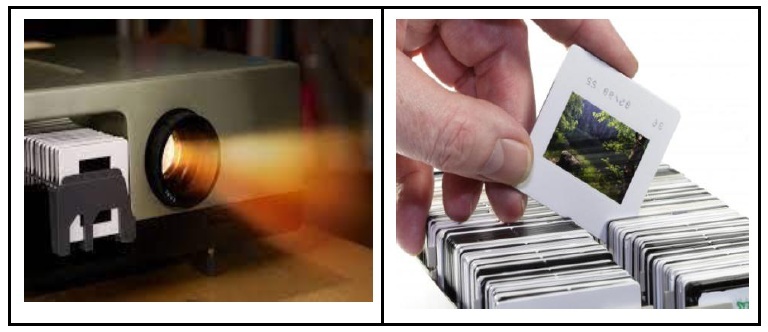
The above images are that of a specialized slide projector. Slides are small transparencies mounted in sturdy frames ideally suited to magnification and projection, since they have a very high resolution and a high image quality. There is a tray where the slides are to be put into a particular orientation so that the viewers can see the enlarged erect images of the transparent slides. This means that the slides will have to be inserted upside down in the projector tray.
To show her students the images of insects that she investigated in the lab, Mrs. Iyer brought a slide projector. Her slide projector produced a 500 times enlarged and inverted image of a slide on a screen 10 m away.
(a) Based on the text and data given in the above paragraph, what kind of lens must the slide projector have?
(b) If v is the symbol used for image distance and u for object distance then with one reason state what will be the sign for 𝑣/𝑢 in the given case?
(c) A slide projector has a convex lens with a focal length of 20 cm. The slide is placed upside down 21 cm from the lens. How far away should the screen be placed from the slide projectors lens so that the slide is in focus?
OR
(c)When a slide is placed 15 cm behind the lens in the projector, an image is formed 3 m in front of the lens. If the focal length of the lens is 14 cm, draw a ray diagram to show image formation. (not to scale)
Here at Jagran Josh, we have also provided the CBSE Class 10 Science Sample Paper 2022-23 in pdf format, if you would like to download and print it.
Download CBSE Class 10 Science Sample Paper PDF
Students can also check the marking scheme to plan and study smartly.
The marking scheme of the CBSE Class 10 Science Sample Paper 2022-23 in pdf format is attached below.
Download CBSE Class 10 Science Sample Paper Solution (Marking Scheme) 2022-23
Using the CBSE Class 10 Science Sample Paper 2022-23 and the marking scheme, students can improve their performance strategically. Stay tuned to Jagran Josh for more content related to CBSE Class 10 board exams 2022-23.
| CBSE Class 10 Practice Papers: All Subjects |
Best of luck to all the candidates.
ALSO CHECK:
CBSE Class 10 Science Previous Year Papers with Solutions
CBSE Class 10 Science Important Questions and Answers for 2023 Boards
Comments
All Comments (0)
Join the conversation